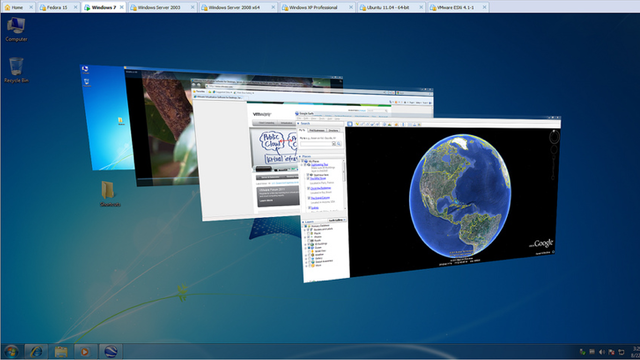
VMware is rolling out major upgrades to Fusion for Mac and Workstation for Windows and Linux, allowing Fusion to take advantage of Lion-specific features of Mac OS X, and boosting integration between Workstation and vSphere to make life easier for developers and IT pros.
VMware Fusion 4, available for download today on VMware’s website, boosts the speed of Windows applications running in a virtual machine on Mac desktops, while allowing them to be added to Launchpad and Mission Control, the new application organization features of Lion. Users can also switch between Windows applications using Lion’s new trackpad gestures and run apps in full-screen mode.
Because Lion allows users to run multiple copies of Mac OS X on the same machine, Fusion 4 adds support for this feature, “allowing users to get more from their Mac by running OS X Lion, OS X Lion Server, Mac OS X Snow Leopard Server and Mac OS X Leopard Server in virtual machines,” VMware says. These new features bring VMware up to par with rival Parallels, whose Desktop for Mac product was upgraded earlier this month to support Launchpad and Mission Control, full-screen Windows apps, and the ability to run multiple copies of OS X on the same machine.
VMware is simultaneously upgrading Workstation, the company’s first product released 12 years ago, to the eighth major version, bringing enhanced integration with vSphere, VMware’s flagship hypervisor and server virtualization management software.
Workstation for Windows and Linux is targeted at IT administrators who need to test new operating system releases or application patches, as well as business users like sales pros who need to demo apps running on a laptop, says VMware’s Pat Lee, director of end-user computing.
Workstation 8, the biggest upgrade in several years, is focused on letting Workstation users take greater advantage of network-connected resources, Lee says.
For example, Workstation 8 lets users drag and drop a virtual machine from the desktop and upload it to vSphere so it can run on ESXi Server. Prior to this upgrade, that process required downloading a separate tool and was a bit cumbersome, Lee says. The new Workstation can also act as a server, allowing workgroups to share access to virtual machines over a customer’s network.
Additionally, Workstation virtual machines can now use up to 64GB of RAM, double the previous limit, and support USB 3.0 and Bluetooth. VMware said both Workstation and Fusion have improved 3D graphics performance along with simplified menus and user interfaces.
VMware declined to say how many users of Workstation exist, but the integrations with vSphere seem designed to maintain the product’s importance as the IT world moves to more heavily virtualized infrastructures. Fusion for Mac, meanwhile, appeals to a more general audience of users who have switched from Windows to Mac, but also has uses for developers. Fusion supports more than 200 guest operating systems, including pretty much any type of Linux or Unix, Lee says. Enhanced snapshot functionality, meanwhile, can help users roll back to previous versions of an operating system, just like you can in Mac’s Time Machine, in case a change made to the system doesn’t work as expected.
Fusion 4’s full price is $79.99, but is available until the end of the year for $49.99, and customers who purchased Fusion 3 on or after July 20 will get a free upgrade. Workstation 8 costs $199, or $99 for upgrades from versions 6 or 7.
Update: One reader asks if Fusion will support the desktop version of Snow Leopard. We asked VMware and received this response: "Based on the current Apple EULA, you are only allowed to virtualize the server version of Leopard and Snow Leopard. We are able to virtualize everything that they let us virtualize including OS X Lion Client & Server."
reader comments
42